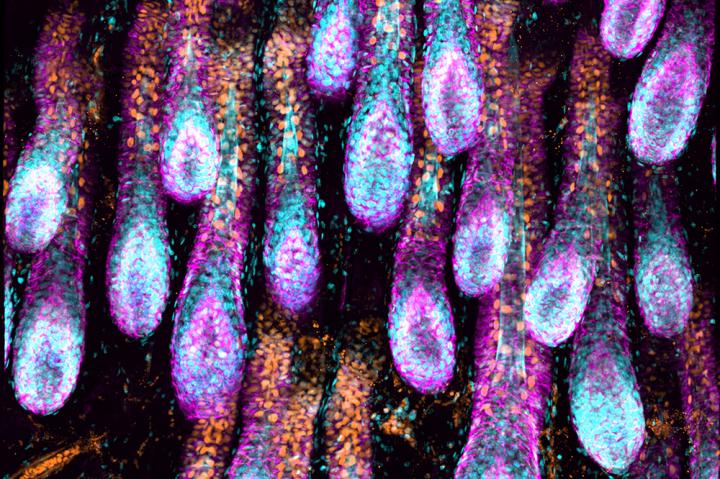Lymphatic system found to play key role in hair regeneration

Growing hair follicles Credit: Robin Chemers Neustein Laboratory of Mammalian Cell Biology and Development at The Rockefeller University Usage Restrictions: Image may only be used to illustrate research described in the accompanying release.
Until now, scientists were uncertain whether the stem cells themselves could instruct other stem cells to form new skin by reshaping their niche. But new research in Science, led by Elaine Fuchs, the Rebecca C. Lancefield Professor, indicates that stem cells can indeed influence tissue regeneration.
The study identifies a molecular coordination tool used by stem cells to signal across niches.
The researchers also discovered a new component of the niche: a specialized type of vessel called lymphatic capillaries, which transport immune cells and drain excess fluids and toxins from tissues.
These capillaries form an intimate network around the stem cell niche within each hair follicle, the study showed, thereby interconnecting all its niches.
“By turning the skin completely transparent,” says postdoctoral fellow Shiri Gur-Cohen, “we were able to reveal the complex architecture of this network of tubes.”
Hair-follicle stem cells control the behavior of lymphatic capillaries by secreting molecules that act as an on-off switch for drainage, the scientists found, enabling them to control the composition of fluids and cells in the surrounding locale and ultimately synchronize regeneration across the tissue.
“The involvement of the lymphatic system in this process is a new concept,” says Fuchs, “and might potentially provide new therapeutic targets for lymph-related conditions such as wound-healing defects and hair loss.”
Media Contact
All latest news from the category: Life Sciences and Chemistry
Articles and reports from the Life Sciences and chemistry area deal with applied and basic research into modern biology, chemistry and human medicine.
Valuable information can be found on a range of life sciences fields including bacteriology, biochemistry, bionics, bioinformatics, biophysics, biotechnology, genetics, geobotany, human biology, marine biology, microbiology, molecular biology, cellular biology, zoology, bioinorganic chemistry, microchemistry and environmental chemistry.
Newest articles

A universal framework for spatial biology
SpatialData is a freely accessible tool to unify and integrate data from different omics technologies accounting for spatial information, which can provide holistic insights into health and disease. Biological processes…

How complex biological processes arise
A $20 million grant from the U.S. National Science Foundation (NSF) will support the establishment and operation of the National Synthesis Center for Emergence in the Molecular and Cellular Sciences (NCEMS) at…

Airborne single-photon lidar system achieves high-resolution 3D imaging
Compact, low-power system opens doors for photon-efficient drone and satellite-based environmental monitoring and mapping. Researchers have developed a compact and lightweight single-photon airborne lidar system that can acquire high-resolution 3D…





















